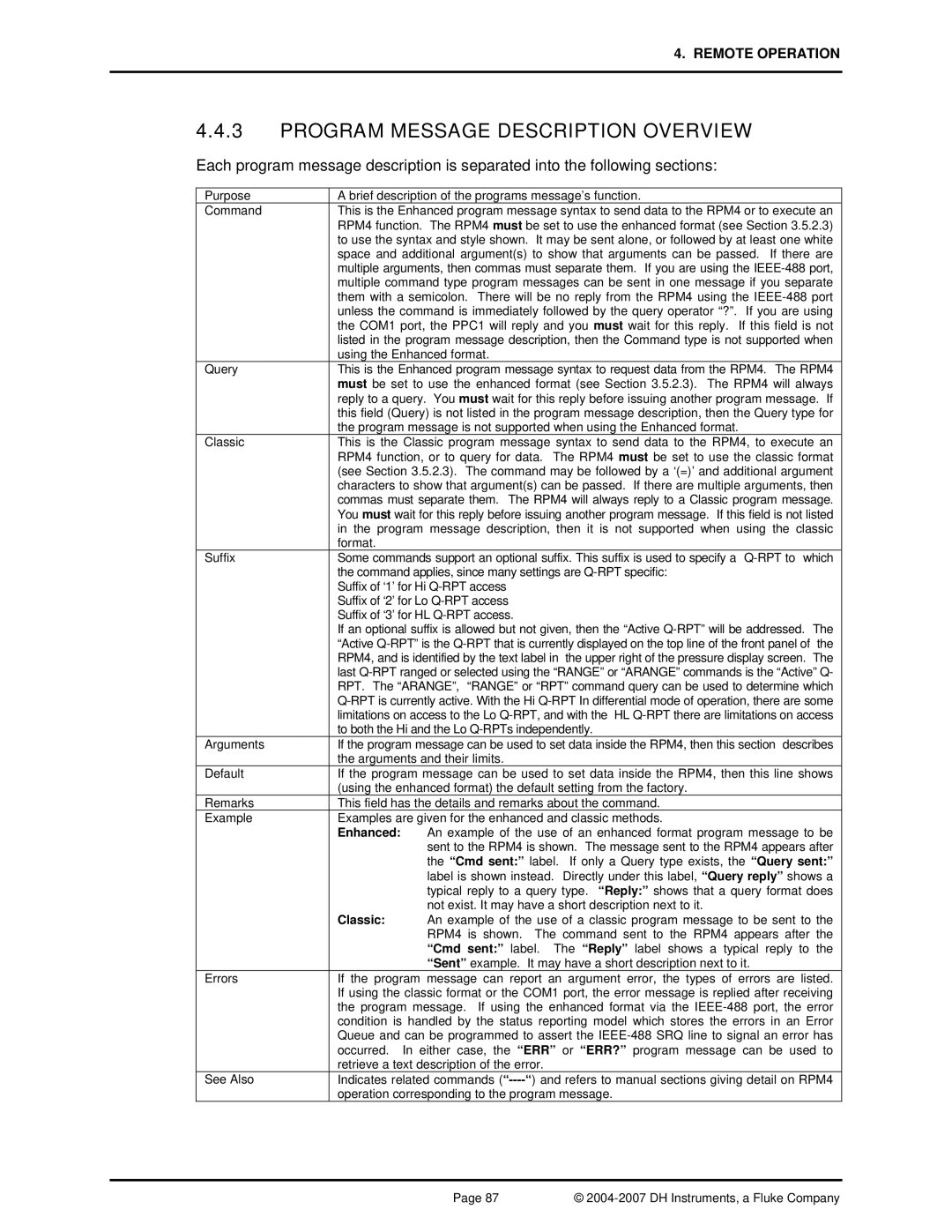
4. REMOTE OPERATION
4.4.3 | PROGRAM MESSAGE DESCRIPTION OVERVIEW | ||
Each program message description is separated into the following sections: | |||
|
|
| |
Purpose |
| A brief description of the programs message’s function. | |
Command |
| This is the Enhanced program message syntax to send data to the RPM4 or to execute an | |
|
| RPM4 function. The RPM4 must be set to use the enhanced format (see Section 3.5.2.3) | |
|
| to use the syntax and style shown. It may be sent alone, or followed by at least one white | |
|
| space and additional argument(s) to show that arguments can be passed. If there are | |
|
| multiple arguments, then commas must separate them. If you are using the | |
|
| multiple command type program messages can be sent in one message if you separate | |
|
| them with a semicolon. There will be no reply from the RPM4 using the | |
|
| unless the command is immediately followed by the query operator “?”. If you are using | |
|
| the COM1 port, the PPC1 will reply and you must wait for this reply. If this field is not | |
|
| listed in the program message description, then the Command type is not supported when | |
|
| using the Enhanced format. | |
Query |
| This is the Enhanced program message syntax to request data from the RPM4. The RPM4 | |
|
| must be set to use the enhanced format (see Section 3.5.2.3). The RPM4 will always | |
|
| reply to a query. You must wait for this reply before issuing another program message. If | |
|
| this field (Query) is not listed in the program message description, then the Query type for | |
|
| the program message is not supported when using the Enhanced format. | |
Classic |
| This is the Classic program message syntax to send data to the RPM4, to execute an | |
|
| RPM4 function, or to query for data. The RPM4 must be set to use the classic format | |
|
| (see Section 3.5.2.3). The command may be followed by a ‘(=)’ and additional argument | |
|
| characters to show that argument(s) can be passed. If there are multiple arguments, then | |
|
| commas must separate them. The RPM4 will always reply to a Classic program message. | |
|
| You must wait for this reply before issuing another program message. If this field is not listed | |
|
| in the program message description, then it is not supported when using the classic | |
|
| format. |
|
Suffix |
| Some commands support an optional suffix. This suffix is used to specify a | |
|
| the command applies, since many settings are | |
|
| Suffix of ‘1’ for Hi | |
|
| Suffix of ‘2’ for Lo | |
|
| Suffix of ‘3’ for HL | |
|
| If an optional suffix is allowed but not given, then the “Active | |
|
| “Active | |
|
| RPM4, and is identified by the text label in the upper right of the pressure display screen. The | |
|
| last | |
|
| RPT. The “ARANGE”, “RANGE” or “RPT” command query can be used to determine which | |
|
| ||
|
| limitations on access to the Lo | |
|
| to both the Hi and the Lo | |
Arguments |
| If the program message can be used to set data inside the RPM4, then this section describes | |
|
| the arguments and their limits. | |
Default |
| If the program message can be used to set data inside the RPM4, then this line shows | |
|
| (using the enhanced format) the default setting from the factory. | |
Remarks |
| This field has the details and remarks about the command. | |
Example |
| Examples are given for the enhanced and classic methods. | |
|
| Enhanced: | An example of the use of an enhanced format program message to be |
|
|
| sent to the RPM4 is shown. The message sent to the RPM4 appears after |
|
|
| the “Cmd sent:” label. If only a Query type exists, the “Query sent:” |
|
|
| label is shown instead. Directly under this label, “Query reply” shows a |
|
|
| typical reply to a query type. “Reply:” shows that a query format does |
|
|
| not exist. It may have a short description next to it. |
|
| Classic: | An example of the use of a classic program message to be sent to the |
|
|
| RPM4 is shown. The command sent to the RPM4 appears after the |
|
|
| “Cmd sent:” label. The “Reply” label shows a typical reply to the |
|
|
| “Sent” example. It may have a short description next to it. |
Errors |
| If the program message can report an argument error, the types of errors are listed. | |
|
| If using the classic format or the COM1 port, the error message is replied after receiving | |
|
| the program message. If using the enhanced format via the | |
|
| condition is handled by the status reporting model which stores the errors in an Error | |
|
| Queue and can be programmed to assert the | |
|
| occurred. In either case, the “ERR” or “ERR?” program message can be used to | |
|
| retrieve a text description of the error. | |
See Also |
| Indicates related commands | |
|
| operation corresponding to the program message. | |
Page 87 | © |
